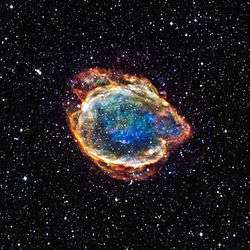Failed supernova
A failed supernova is an astronomical event in time domain astronomy in which a star suddenly brightens as in the early stage of a supernova, but then does not increase to the massive flux of a supernova. They could be counted as a subcategory of supernova imposters. They have sometimes mis-leadingly been called unnovae.[1]
Failed supernovae are thought to create stellar black holes by the collapsing of a red supergiant star in the early stages of a supernova. When the star can no longer support itself, the core collapses completely, forming a stellar-mass black hole, and consuming the nascent supernova without having the massive explosion. For a distant observer, the red supergiant star will seem to wink out of existence with little or no flare-up. The observed instances of these disappearances seem to involve supergiant stars with masses above 17 solar masses.
Failed supernovae are one of several events that theoretically signal the advent of a black hole born from an extremely massive star, others being hypernovae (SLSN), long-duration gamma-ray bursts (GRB), etc.
Structure and process
Theoretically, a red supergiant star may be too massive to explode into a supernova, and collapse directly into being a black hole, without the bright flash. They would however generate a burst of gravitational waves. This process would occur in the higher mass red supergiants, explaining the absence of observed supernovae with such progenitors.[2][3][4][5]
List of failed supernovae candidates
| Event | Date | Location | Notes | |
|---|---|---|---|---|
| NGC3021-CANDIDATE-1 | NGC 3021 09h 50m 55.39s +33° 33′ 14.5″ |
Disappearance of a 25-30 MSun F8 red supergiant observed in archival HST data | [2][6] | |
| N6946-BH1 | March 2009 | NGC 6946 20h 35m 27.56s +60° 08′ 08.2″ |
Disappearance of a 18-25 MSun red supergiant | [2][7][5] |
List of surveys for failed supernovae
| Survey | Date | Location | Notes | |
|---|---|---|---|---|
References
- ↑ Woosley, S. E.; Heger, Alexander (2012). "Long Gamma-Ray Transients from Collapsars". The Astrophysical Journal. 752: 32. arXiv:1110.3842
 . Bibcode:2012ApJ...752...32W. doi:10.1088/0004-637X/752/1/32.
. Bibcode:2012ApJ...752...32W. doi:10.1088/0004-637X/752/1/32. - 1 2 3 Lee Billings (November 2015). "Gone Without A Bang". Scientific America. 313 (5): 26–27. Bibcode:2015SciAm.313e..26B. doi:10.1038/scientificamerican1115-26b.
- ↑ Jon Voisey (2 April 2011). "Finding the Failed Supernovae". Universe Today.
- ↑ Colin Robson (20 January 2014). "Failed Supernovae". From Quarks to Quasars.
- 1 2 Eugene Myers (27 September 2016). "This star was so massive it ate itself before it could go supernova". Astronomy Magazine.
- ↑ "Gone without a bang: An archival HST survey for disappearing massive stars". Monthly Notices of the Royal Astronomical Society (published November 2015). 453 (3): 2885–2900. 21 July 2015. arXiv:1507.05823
 . Bibcode:2015MNRAS.453.2885R. doi:10.1093/mnras/stv1809.
. Bibcode:2015MNRAS.453.2885R. doi:10.1093/mnras/stv1809. - ↑ Gerke, J. R.; Kochanek, C. S.; Stanek, K. Z. (6 November 2014). "The Search for Failed Supernovae with The Large Binocular Telescope: First Candidates". Monthly Notices of the Royal Astronomical Society (published July 2015). 450 (3): 3289–3305. arXiv:1411.1761
 . Bibcode:2015MNRAS.450.3289G. doi:10.1093/mnras/stv776.
. Bibcode:2015MNRAS.450.3289G. doi:10.1093/mnras/stv776.
External links
| Look up failed supernova or unnova in Wiktionary, the free dictionary. |

